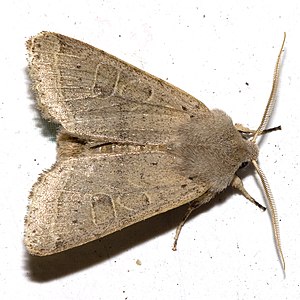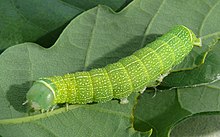Round-winged kitten owl
| Round-winged kitten owl | ||||||||||||
|---|---|---|---|---|---|---|---|---|---|---|---|---|

Round-winged kitten owl ( Orthosia cerasi ) |
||||||||||||
| Systematics | ||||||||||||
|
||||||||||||
| Scientific name | ||||||||||||
| Orthosia (Monima) cerasi | ||||||||||||
| ( Fabricius , 1775) |
The round-winged kitten-owl ( Orthosia (Monima) cerasi , syn .: O. stabilis ), also called common kitten-owl , red-yellow spring- owl and common spring- owl, is a butterfly ( moth ) from the family of owl butterflies (Noctuidae).
features
The round-winged kitten owl is a medium-sized owl butterfly with a wingspan of 34 to 40 millimeters. Their forewings are very variable in color and vary from light beige to brown to cinnamon and red-brown. In contrast, the drawing is not very variable. It mainly consists of the light border of the conspicuously large ring and kidney flaws and the light, almost straight wavy line, which is often darker inside. The inner and outer transverse lines are usually designed as a series of black points, but occasionally also as a continuous black jagged line. The outer transverse line is strongly curved near the front edge. The cone flaws are sometimes missing or very indistinct, ring and kidney flaws can also be connected to one another. The basal transverse line is indicated by a few black dots. An indistinct middle shadow is sometimes present. The veins in the border area are often lighter than the basic color. The antennae of the males are combed short in contrast to the thread-like ones of the females. The apex of the forewings is only slightly pointed. The hind wings are monochrome brown to yellow-brown with yellowish-brown fringes.
The yellowish white egg is hemispherical with a strongly flattened base. The base is ribbed and slightly greenish, the central zone and the band are carmine red.
The caterpillars are about 40 millimeters long. They are yellow-green, have small, yellow points and fine, yellowish side and back lines all over their body. There is a wide, yellow horizontal stripe on the 11th segment. The head is greenish with dark spots.
The doll is reddish brown and stocky. The blunt cremaster has four diverging bristles in the male and two in the female.
Similar species
The round- winged cat -owl is very similar to the pointed-winged cat-owl ( Orthosia gracilis ). The apex of the forewing of the latter kind is somewhat more pointed (name!). The blemishes are on average somewhat larger in Orthosia cerasi . Orthosia gracilis is on average slightly larger than Orthosia cerasi .
Also Orthosia dalmatica is hardly of Orthosia cerasi to distinguish. However, the distribution area of this species is limited to the Dalmatian coastal region, Montenegro, Albania, northern Greece, Macedonia and southern Bulgaria and, at least in Central Europe, cannot be confused with Orthosia cerasi . Orthosia cerasi is lighter, has lighter hind wings and less red fore wings. A clear distinction is only possible by examining the male or female genital organs.
Geographical distribution and habitat
The species is distributed practically in the entire western Palearctic (with the exception of northern Fennoscandia and northern Russia). In the east the distribution area extends to the Middle East, Asia Minor and the Caucasus region.
The species inhabits shrubbery, hedges and forest edges, but also bog areas, gardens and parks and is found in practically all types of forests (with the exception of pure pine forests). In the Alps it rises up to 2000 m above sea level. It is one of the most common native Orthosia species.
Way of life
The round-winged kitten-owl is univoltin , i. H. only one generation is formed each year. The moths appear at the end of February / beginning of March. Depending on the spring weather, individual moths can hatch earlier; butterflies were found in October. The flight time lasts until May or June, depending on the altitude. The nocturnal moths usually fly at dusk. They are often numerous when sucking nectar on pussy willows or early flowering shrubs such as. B. Cornelian cherry ( Cornus mas ) to be found, or also on leaking tree sap. They are strongly attracted to artificial light sources and also come to the bait . The eggs are deposited in small groups of ± 20 eggs close together on the underside of the leaves of the host plants. The caterpillars are found from May to June. They feed on the leaves of various deciduous trees and shrubs, such as. As aspen ( Populus tremula ), willow ( Salix caprea ), beech ( Fagus sylvatica ), English oak ( Quercus robur ), black elderberry ( Sambucus nigra ) and others. The caterpillars pupate in a cave in the earth, the pupae overwinter.
swell
Individual evidence
- ↑ Red list at Science4you
- ↑ a b c Ronkay et al. (2001: pp. 28–30)
- ↑ a b c d Walter Forster , Theodor A. Wohlfahrt : The butterflies of Central Europe. Volume 4: Owls. (Noctuidae). Franckh'sche Verlagshandlung, Stuttgart 1971, ISBN 3-440-03752-5 .
- ↑ Axel Steiner on the distinction between Orthosia cerasi and Orthosia gracilis in the Lepiforum
literature
- Heiko Bellmann : The new Kosmos butterfly guide. Butterflies, caterpillars and forage plants. Franckh-Kosmos, Stuttgart 2003, ISBN 3-440-09330-1 .
- Günter Ebert (Ed.), Axel Steiner: The butterflies of Baden-Württemberg . Volume 7, Moths V (Owls (Noctuidae) 3rd part). Ulmer Verlag Stuttgart 1998. ISBN 3-800-13500-0
- Lázló Ronkay, José Luis Yela, Márton Hreblay: Hadeninae II. - Noctuidae Europaeae, Volume 5. , Sorø, 2001, ISBN 8-789-43006-9
Web links
- www.lepiforum.de
- www.insektenbox.de
- Moths and Butterflies of Europe and North Africa (English)
- Ian Kimber: Guide to the moths of Great Britain and Ireland (English)
- Orthosia cerasi at Fauna Europaea
